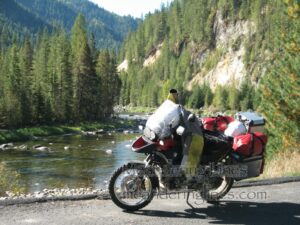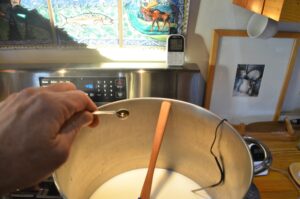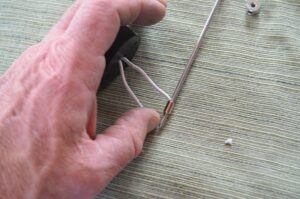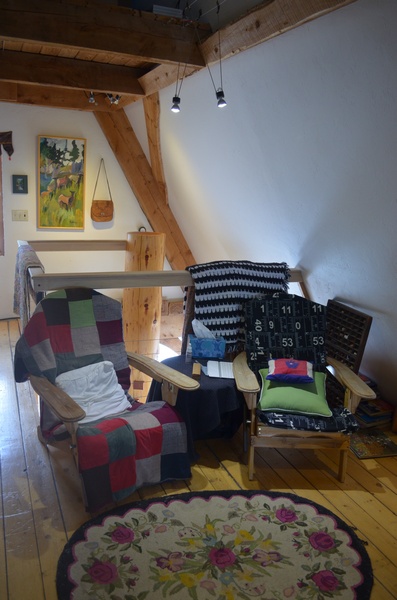Wind, speed, passing cars, the drone of the engine, a monotonous ribbon of lined concrete passing through a familiar landscape. So many times I have come this way.
Silence from my companion.
This is how it always starts. We left latter than I had hoped, as usual, probably the unconscious result of a struggle for control. Push, push, go, go escape. We aren’t the same, I am results oriented, Lori is a planner. Left on my own I’d get where I was going on schedule without enjoying it and she would get there whenever, but would experience the details of the journey. In the end the combination of personalities works well, but at the beginning of a trip it takes some time to adjust to the new rhythms for both of us.
It doesn’t help that it is a long way to a point where the act of travel departs from the routine and the excitement of new experiences begin. In reality new experiences can begin anytime your mind is open to them, but mine usually isn’t at the beginning of a trip. Going anyplace in Montana requires a good distance of travel, and travel is part of my working routine. For me, time off and the ability to acclimate to time off is benefited by a change of environment. I don’t consider myself uptight, but I am. People who know me well see it, acquaintances generally don’t. Lori lives with it and is unsure as to whether I ever chill out.
Stopping and living in the moment is what travel is about, but I have trouble in the beginning. We got a late start by my designs which means we have to make time, we actually don’t but I have a schedule. We stop in Deer Lodge for fuel after an hour and a half in the saddle. There hasn’t been much for conversation. Lori has a headache and needs to pee, I fuel up. Fifteen minutes break, moving again.
It started out chilly this morning, about 55 degrees, but sunny with scattered clouds. The light is flat as we ride through a landscape that invites travelers, while we press on with only the intent of moving through it. The miles have been uneventful as I try to focus on the task of riding, becoming aware of our surroundings and giving the task the attention it deserves. Distractions keep intruding; did I leave enough instructions for the house sitter, are my task at work finished, what am I going to come back to. I struggle to start living in the present, it won’t happen today.
We make Missoula by 12:30 and stop for lunch. Three hours is good time if you’re trying to be efficient, but making that kind of time from Bozeman to Missoula requires you travel along I-90. I drive this regularly; unfortunately there aren’t a lot of other options unless you are planning to see Montana, then you will need to make them. We’re not interested in spending time in Montana on this trip since we do it regularly, some of it as part of my job. Even with extra time there are not a lot of alternatives for the travel between Bozeman and Missoula that are direct, the mountains get in the way. If you want to ride paved routes you can contrive them along highway 200 by way of Helena or by piecing your way though Virginia City and into Darby then up Highway 93. You would have to plan for between 4.5 and 6 hours compared to 3 on the interstate. If you don’t need to get anywhere and you can ride dirt, then you have more options.
We stopped at Quiznos for lunch. Fast food and chains are never a preference and are usually avoided, but I’m want to move on. Once stopped it always takes longer than I think it should. Even though we made good time to Missoula, our lunch break took an hour and a half so the time gained was lost at the stop. Its early in the trip and I’m not yet able to enjoy the moment, even though the weather has become nearly perfect for lunch in the sun.
We leave Missoula on highway 12 which goes over Lolo pass then down the Lochsa River. In the back of my mind I hope to get to a place on the Wallowa-Whitman National Forest about 30 miles North of Enterprise Oregon to camp. I’ve ridden by this area in the past and it appears that if you were to pull off on one of the Forest roads a little ways you could find a place to camp that would allow you to wake up to the sun rise over Hells Canyon. Of course it doesn’t hurt that camping in the national forest is free.
Going over Lolo Pass I finally feel I am leaving the routine and open to new possibilities, encounters and experiences.
Highway 12 is a great road if there isn’t a lot of traffic and today it is a great road, especially on a motorcycle. The road corridor follows the wild and scenic Lochsa River through its canyon. The temperature is rising as we descend down the river canyon, it’s in the high 70’s but it would be much higher if they weren’t moderated by the river. The canyon is fairly narrow and so the road is curvy, a good thing on a motorcycle.

A rest on the Lochsa
Since I’ve loosened up a little bit we have started to communicate more. We have communication devices that are attached to our helmets that allow us to talk as we ride. We don’t talk much as a rule, but share observations, plans and needs. Not all motorcyclists like the communications systems, for some part of the pleasure is the time alone in your head even when traveling with a companion. For me being able to talk to Lori reduces potential frustration when we are trying to make decisions on the fly and allows us to share observations that we can reflect on and enjoy later.
In general with or without communications traveling with a companion on a motorcycle is an intimate experience. The intimacy is derived from the close physical contact on the motorcycle seat, the coordination required to perform the task of riding proficiently, and a shared experience. The person on the back is referred to as a pillion. Riding pillion is not a passive act; the pillion affects the way the bike handles especially when the riding is spirited. With a good pillion and pilot the bike can perform at a high level, while both parties get satisfaction from the riding experience. Lori has become a good pillion.
When we started motorcycle touring, gas prices were high, our money was short and the motorcycle seemed like a tool that would give us more opportunity to travel. We weren’t expecting the other experiences it has made available. Motorcycle travel is not just another way to be transported but an experience of its own.
Unlike traveling in a car, you are part of the environment, if it’s cold your cold, if it’s wet your wet, and then sometimes, it’s perfect. Even though perfect is nice, cold & wet or any other condition lends itself to the experience as well. Some of our best stops have been during adverse conditions creating serendipitous experiences in the moment. It’s not just about the conditions but an experience of the senses as you ride, you feel the wind and smell your surroundings, riding by an onion field you sense the fields, the smell of the fresh tilled earth, the sweet onions that have just been harvested, as you hear and see birds along the marshes beside the fields. True it’s not as intimate as riding a bike or walking, but you can’t cover 4000 miles in 2 weeks riding a bike or walking. You are consciously living in the moment, not just processing time prior to arrival at your destination.
The interstate systems have created a homogenous landscape dominated by the ubiquitous chains of fuel, food and lodging at exits. They provide a fast efficient route of travel across the country at the expense of culture. In general my preference is to travel the back roads and alternate routes across the country, not only are they more pleasant riding, but they allow you to experience the local culture as it has developed to support the needs of a community.
For us stopping is as much a part of motorcycle travel as the riding itself. We are always looking for places that are creative or unique, be they food related or cultural, to stop, rest and catch up on conversation. Along with the mandatory reasons for stopping we stop as a break from the physical environment, which when it is challenging can increase the appreciation of the stop.
On one trip we rode into an unexpected snow storm, furthermore we had just come over a mountain pass and were severely chilled, this was before we had heated gear, as we came into a little town we stopped at a coffee house/bookstore with a fireplace to warm up. Once inside and out of our riding clothes in front of the fire, we spent the next hour warming up and enjoying coffee while visiting with the locals. This establishment was not Starbucks or one of their many competitors, but what chains do their best to emulate and sell. This is the real thing, and we wouldn’t have found and experienced it except that we were cold, conditions were bad and we needed to warm up. What we found was a piece of real culture, something many businesses try to sell today; they are poor imitations once you have experienced the real thing. The problem with these types of experiences is that once you have experienced something real, there is no being satisfied with an imitation. Hence the need to keep riding and looking, finding those things that are real in society, people who do what they do because they care. In the end that is what travel is about.
For me travel goes beyond the physical environment and is a conduit to ideas and cultures, hopefully an opportunity to increase my awareness of the conditions and needs of other peoples so I can be part of the changing world. It is a mindset and really only requires openness, be it for an hour, a day or a week.
As we transitioned from the Lochsa River drainage to the Clearwater River drainage on Highway 12 the road changes from what we call twisties to sweepers and the valley gets broader resulting in an increase in the temperature. Twisties and sweepers refer to the types of curves in the road; sweepers are long gently curves whereas twisties refer to tight turns where one follows another. The increasing temperature is a problem for us, our ideal riding temperatures are between 50 degrees and 85 degrees Fahrenheit, and if there is a choice when riding outside of that range I would choose lower temps as long as there is no ice.
By 5:30 and we are about 20 miles from Lewiston Idaho, the temperature is nearing 100 degrees Fahrenheit, there is no cooling from the hot wind. The heat is sucking the energy out of our bodies and as we get closer to Lewiston the temperature continues to rise. By this time it is obvious that we aren’t going to make it farther than Lewiston today and we will have to stop. Its 102 degrees as I stop on the outskirts of Lewiston to check my hotel finder app on my smart phone to see if there are any cheap hotels available. This is a copout, I had planned to camp, but we are both miserably hot and the idea of air conditioning is an alluring siren. While sweating in my gear on the side of the road the app dashes my hopes of cheap hotel lodging and we head to the Hells Gate State Park Campground at the entrance to Hells Canyon south of town. Lack of options kept us honest to our budget and plans. We had planned to camp most of the trip, both to reduce expenses and to maintain contact with the environment. There are only rare occasions where a hotel room is actually part of the culture or environment of a place.
We had a simple dinner of chips, humus, salami and a box of wine while we relaxed, glad that we had been forced to camp.






















